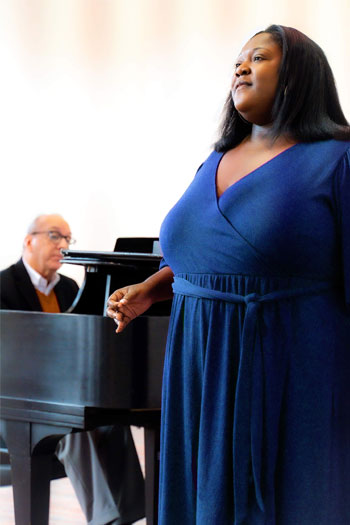Auditions
 Prospective students seeking admission into the Department of Music must complete either a live or virtual audition with the music faculty prior to the semester of initial enrollment. Recorded accompaniments are not allowed for live auditions except in certain circumstances for students completing an audition for the Sound, Recording, Technology program; an accompanist will be provided if requested.
Prospective students seeking admission into the Department of Music must complete either a live or virtual audition with the music faculty prior to the semester of initial enrollment. Recorded accompaniments are not allowed for live auditions except in certain circumstances for students completing an audition for the Sound, Recording, Technology program; an accompanist will be provided if requested.
Application materials should be received and an audition completed at least six weeks before the beginning of the prospective student’s first semester as a music major to ensure a place in applied music, ensembles and required music courses. Priority music scholarship consideration is given to student applications that are complete (audition and application finished) prior to April 30. No audition or interview is required for the music minor degree unless a service scholarship is requested.
VSU Department of Music Audition Dates
The Department of Music will host several audition days (both in person and virtual) for prospective students planning to major in music. Please review our upcoming dates and scan the QR code below to schedule an audition.
Specific Requirements:
Voice
Two prepared pieces (memorized) that demonstrate vocal technique and musicianship, one in a foreign language and one in English. At least one piece should be from the seventeenth or eighteenth century classical art-song or opera tradition. Classical repertoire may include art songs, arrangements of folk songs or spirituals, or arias from oratorios and operas. Pop songs or voice parts from choral music are not acceptable for your audition.
Piano
- All major scales with hands together, two octaves.
- Two prepared pieces, memorized. One should be either a Baroque piece or movement (Bach, Handel; invention, fugue, prelude, suite movement) or a movement from a Classical piano sonata (Haydn, Mozart, Beethoven). The second piece can be selected from the piano repertoire of the nineteenth and twentieth centuries.
- Students auditioning for Jazz Studies concentration should also play a jazz standard and demonstrate soloing and comping.
Stringed Instruments
Violin
- One major scale and one minor scale with arpeggio, three octaves (except for G).
- One movement of Bach unaccompanied sonata or partita or the first movement of a Mozart concerto (numbers 3, 4, 5).
Viola
- One major scale and one minor scale with arpeggio, three octaves.
- Any movement from a Bach cello suite.
Cello
- One major scale and one minor scale with arpeggio, three octaves.
- Any movement from a Bach cello suite.
Bass
- One major scale and one minor scale with arpeggio.
- Any movement from a Bach cello suite adapted for bass.
Harp
- Two prepared pieces or movements in contrasting styles demonstrating techniques (rolled chords, pedal changes, arpeggios, etc.) and musicality.
- One orchestral excerpt or cadenza.
Guitar
- Major and minor scales (two octaves).
- Two contrasting standard etudes (e.g., Sor, Carcassi, Guiliani, Brouwer) or one etude and one piece from the classical repertoire.
Electric Bass (Jazz/Commercial)
- Major and minor scales.
- Prepared piece (jazz standard, gospel, R&B, blues, rock, funk, or fusion).
- Play melody
- Improvise groove or walking line
- Incorporate a solo
Guitar (Jazz/Commercial)
- Major and minor scales, two octaves in three positions.
- Demonstrate the following chord types in two positions: Maj7, min7, min7(♭5), dim7.
- Prepared piece selected by the student from the following criteria:
- A performance of a Real Book standard with a backing track demonstrating melodic playing, comping, and soloing
- A single melodic line guitar solo based on a transcription of a jazz, pop, R&B, or rock song
- A solo guitar “chord melody” performance of a song from the jazz, pop, R&B, or rock genre
- A finger style and/or pick style piece using alternate tunings or standard tuning
Wind Instruments
- All major scales and chromatic scale through the most accepted and practical range of the
- Two prepared solo pieces of contrasting style (showing both technical and lyrical aspects of playing) composed or arranged for the specific instrument. One of the two may be an etude from a standard collection.
- Students auditioning for Jazz Studies concentration should also play a jazz standard with head and a solo chorus.
Percussion
- Rudiments on snare drum (PAS 40 standard rudiments).
- Prepared snare drum selection.
- Major and minor scales on mallets.
- Prepared mallet selection (2 or 4 mallets).
- Prepared timpani selection.
- Various styles on drum set (rock, latin, jazz, reggae).
Music Literacy Assessment
The music literacy assessment is part of the music major audition process. Students who have a successful performance audition but perform less well on the assessment may be afforded probationary status pending the completion of supplemental instruction, which normally includes the Music Fundamentals and Piano Fundamentals courses.
The assessment includes pitch notation, rhythmic notation, meters and meter signatures, major and minor scales, key signatures, interval identification, and triad quality identification. It also includes aural identification of scale types, intervals, triad qualities, rhythmic patterns, and melodic patterns.
Students may prepare by consulting any music theory textbook or resource. The following websites can be very helpful:
MusicTheory.net has tutorials and practice exercises, as well as mobile apps to help you practice.
Teoria has instructional content and practice exercises.
Basics of Classical Harmony and Counterpoint - YouTube series by Seth Monahan (first 8 or 9 videos)
(https://www.youtube.com/playlist?list=PLtVmMer7Hz1H4JXHA6NGsawkkkTpnJKyI);